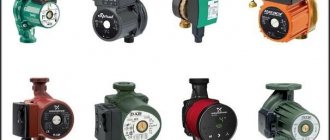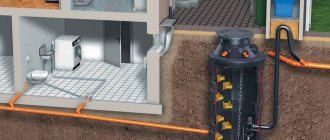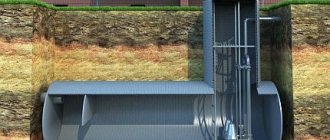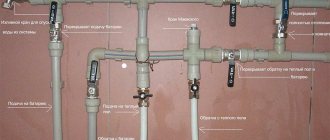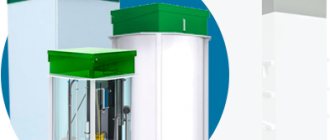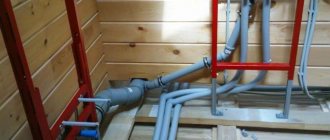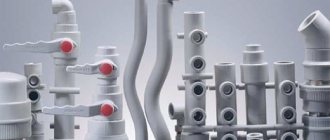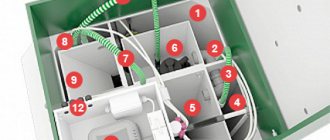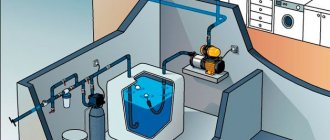It is important not only to correctly lay the sewer pipes and connect them to the septic tank. It is necessary that the wastewater goes into the sump in a timely manner and does not create problems in the form of an unpleasant odor in the house. In some cases, it may be necessary to install a sewage pumping station for domestic wastewater. Pumps vary in design, power, and method of operation. Before going to the store, you need to have some understanding about these units in order to ask the right questions to the manager. You may need to bring a sewer line plan to find a pumping station that meets all requirements.
Purpose of a pumping station for a private house
Construction of a home sewer pump
A sewer pumping station for a private home is an additional device that consumes electricity, so residents try to install gravity systems so as not to pay extra. This is possible in cases where the septic tank is located below the house, and the pipes can be laid at a slope, since the length of the main line is short.
If for some reason the sewage pit is located higher than the house, the waste will not be able to flow on its own. The bathroom may be located in the basement, so the drains must first be raised, and then they will flow into the main pipe and then flow on their own. The same situation occurs when there is an obstacle in the way of sewer pipes. The close location of groundwater does not allow the required slope to be maintained, so the section of the highway is forced to be located vertically. In all these cases, it is necessary to create increased pressure so that the liquid does not stagnate in the pipes. In winter, this can lead to the formation of an ice plug and the sewer system will become impossible to use.
Wastewater contains large particles, which, at low speeds of movement, accumulate in the pipe and block it. This happens in areas where the highway turns or its diameter changes. In difficult terrain, it is difficult to lay pipes in a straight line - you have to go around buildings or obstacles.
Reasons for forced removal of wastewater
Typically, removal of human waste from a sewer system occurs naturally under the influence of gravity. Unfortunately, it is not always possible to practically organize this process at a sufficiently effective level.
Here are a few reasons why a homeowner should consider (or consider) installing a forced drainage system:
- the situation is such that the level of the main sewer drain is located higher than the waste discharge point;
- the waste discharge point is located too far from the main sewer drain;
- wastewater moves through sewer pipes too slowly;
- sewerage often becomes clogged due to errors made during its installation.
Some of these problems may be caused by flaws in the design of the sewer system or its improper redevelopment. But it also happens that, due to the configuration of the building or the topography of the site, the sewer pump station becomes the only choice for the normal operation of the sewer system. Sometimes installing a sewerage system is simply cheaper than completely redoing the sewer system, eliminating previously made mistakes.
Operating principle and main components
Sewage pumping stations forcibly transport wastewater to a septic tank.
Sewage pumping stations can be divided into domestic and industrial. Industrial devices are complex engineering equipment that makes no sense to install in home systems, since their productivity far exceeds the volume of a private home.
For private buildings, units of medium complexity are provided. They are small and compact in size. The type of waste is taken into account - waste from the toilet containing large particles, kitchen waste and waste from the washing machine usually enter the home sewer.
The CNS consists of the following main components:
- a pump or several units of a similar type;
- storage tank.
The pump can be installed directly at the exit of the house or behind the toilet. These mini models have a neat appearance and fit well into the interior of the bathroom.
The storage tank can be compact in size or designed for an entire multi-storey building or even a village.
The operating principle is as follows: the liquid coming from plumbing fixtures is collected in a storage tank. When a certain level is reached, one or more pumps are activated and discharge waste into the sewer pipes. The process is automated, so there is no need to constantly turn on the equipment.
The pipes are equipped with check valves to prevent odors and liquids from getting back into the house. Garbage is retained in the receiving basket, from where it is removed during maintenance and routine cleaning.
The station can operate in three modes:
- at normal times, when the amount of waste does not exceed the norm, one pump is activated;
- during rush hour, when all residents of the house use water, both pumps or all units located inside the storage tank are turned on;
- emergency mode - in the event of a large amount of water entering or both units failing, a warning signal is activated indicating that the station cannot cope with the load.
Manual control is also possible, in which the pumping equipment is started by pressing a button.
Operating principle of a sewer station
What is KNS? This is a tank equipped with:
- Chopper
- Pump
- Pressure sensor.
The equipment starts up automatically. When wastewater enters the tank, which is detected by a pressure sensor, the pump turns on. A drop in the liquid level in the system causes it to stop. That’s the whole working principle – it’s quite simple.
Let's watch a video about what the equipment is and what it serves:
Most water pumping stations have several inlet pipes, which makes it possible to connect several plumbing devices. In addition, the installation of such stations allows you to install a washing machine and dishwasher in the basement, thereby not taking up living space.
Types of pumping stations for a private house
Mini devices are installed behind the toilet or at the exit from the house, from where the KNS pump pumps wastewater into the septic tank. This is a small device in a plastic case, discreet and low noise. It is based on submersible mechanisms with or without a cutting element.
The second type of KNS is larger and more powerful. It is a septic tank with a submersible pumping mechanism, which is turned on when it is necessary to clean the tank and direct the wastewater to the city sewer or sewer truck.
The third option is the most common. This is a stationary device equipped with 2 - 3 submersible pumps, which removes wastewater outside the house into a drainage pit. From there, using fecal units, the liquid is pumped into the next septic tank for filtration through the ground.
Operating principle of the equipment
The equipment operates in this way. Through pipes, wastewater enters a receiving tank, at the bottom of which pumps are fixed. They forcefully pump liquid into a pressure pipeline, and from it into the central sewer system.
The distribution tank contains valves. They are necessary for discharging wastewater into pipes. When operating in standard mode, all valves are open. And equipping the system with a check valve prevents wastewater from returning back. If problems arise in the operation of the pumping station, the valves are closed until the repair work is completed.
Criterias of choice
To drain drainage fluid from the house, a small stationary model is installed. Its power should be comparable to the number of points of water use - bathroom, toilet, washing machine or dishwasher, sinks, swimming pool or sauna. Select according to the parameters of power and volume of the storage tank. It is better if the pump station is equipped with two pumps.
To operate the sewer system of a multi-story building, you will need a large storage tank and several units that will pump out the liquid. An important point is the presence of a cutting mechanism. It is better when there is one, since debris and large waste can clog the outlet pipe.
Selecting a sewage pump based on pressure characteristics
Before purchasing a pumping unit, you need to make sure that it will cope with your tasks. To do this, you need to open the passport and consider the pressure characteristics of the product, which looks like this:
For example, let's say you need to raise wastewater to a height of 4 meters. The pump productivity will be 65 l/min (3.9 m³/h). If this is enough for your needs, then this model is suitable for you. Also, manufacturers often make schematic pictures that show the ratio of the lengths of the vertical and horizontal pressure sections:
Carrying out calculations
When purchasing a complete SPS, there is no need to buy a very expensive device that will operate at 10% of the declared power. A station is selected based on the following indicators:
- dimensions of the equipment - must be suitable for the room in which installation is planned; for a private house it will be an ordinary household appliance that can be placed on an area of 1 sq. m;
- expected flow of waste liquid - depends on the number of residents and the volume of water consumed during rush hour;
- the distance to which the liquid must be removed;
- height of inlet and outlet pipes;
- equipment performance based on the degree of wastewater pollution.
A household SPS can be connected independently, while large-sized devices are formed from several parts designed for specific operating conditions.
Product marking
It is applied to identify the specimen as belonging to a particular model. In this case, the name and main technical characteristics are indicated on the plate.
The installation of such plates on the body is intended to facilitate identification when choosing a product, and with an initial familiarization with the technical characteristics of the product.
Popular manufacturers of fecal pumps
As noted above, fecal pumps are produced by many manufacturers. The most popular of them are:
- Pumps manufactured by Pedrollo . Used for pumping heavily contaminated wastewater. The most popular equipment lines are VXm MC/MCm. The first of them, less powerful, operate on a 220 volt network and have a minimum power of 0.6 kW. They are the most popular for use in fecal sewers in private homes. The permissible size of solid inclusions is 35 millimeters. Main technical characteristics:
- engine voltage – 220 or 380 volts;
- maximum emptying rates from the bottom are 40-55 millimeters;
- working pressure from 15 to 66 liters per hour;
- immersion depth indicators - 8-22 meters;
- the diameter of the outlet pipe is 1.5-2.5 inches.
- Grundfos SEG sewage pump . The unit is equipped with a grinder and is designed for pumping sewage, drainage water, and wastewater. It is capable of pumping wastewater over considerable distances, but the pipe size is limited to 40 millimeters.
Main characteristics of the equipment:
- body material – cast iron;
- the pump is equipped with an impeller adjustment system;
- 2 relays are installed to protect the device from overheating;
- used for pumping to a depth of 10 meters;
- the maximum permissible temperature of the pumped liquid is 40 degrees.
- Sewage pumps Gillex . The company produces two types of pumps – Fekalnik and Drainazhnik, the names of which indicate their purpose. The acceptable size of solid inclusions is 35 millimeters. Main technical characteristics:
- productivity 160-260 liters per hour;
- immersion depth – 6-11 meters;
- installation of a float switch.
- Sulzer – pumps for pressure sewerage. Strictly speaking, this is a station for pumping fecal wastewater with its simultaneous processing to a liquid state. Its advantage is quick installation and startup. The station is equipped with a reliable check valve and a powerful solids grinder.
Vortex
fecal pump is designed for pumping wastewater with strong fibrous contaminants.
Used for domestic purposes. Main technical characteristics:
- power 450-1500 watts;
- pressure 9-18 meters;
- productivity 16-24 cubic meters per hour;
- solid inclusions of 15-42 millimeters are allowed;
- permissible liquid temperature is 40 degrees.
A pump for forced sewerage in a private house in some cases is a forced solution, depending on the landscape of the area in the development region.
Installation of a fecal pump
Installing a sewage pump is a responsible undertaking, on which comfortable and safe living in a private home depends. This in itself is not such a difficult undertaking and can be done independently.
Installation of the SFA SANIPLUS SILENCE pump - INSTALLING THE PUMP
But the stable and correct operation of this system is extremely important. Therefore, it is better to entrust its installation, especially in difficult cases, to specialists. But this does not mean that you do not need to have knowledge of how it works in order to carry out qualified installation control.
Installation features
You can install and connect household water pumping stations following the instructions. These are “sololifts”, which are placed near plumbing fixtures. They are compact and do not require special skills. The instructions indicate step by step the actions that need to be performed.
Another thing is to install a sewer station for a country house. For these works it is better to invite professional craftsmen. Accuracy and correct selection of components, as well as their final configuration, are important here. The sequence of actions is also important. A person who does not have experience and does not understand the nuances of devices will not be able to carry out installation correctly and will lose the manufacturer’s warranty.
Landscaping private territory
Not only sewage drains cause a lot of trouble, but also groundwater and heavy rainfall can turn the area into an impassable swamp. But how to drain all these liquids if the level of the site is lower than the passing main storm sewer pipeline and storage tank? There is a solution, although not the cheapest, but reliable - installing a sewerage system.
Today they are widespread and have already established themselves as one of the most effective devices for drainage.
Operation and Maintenance
Maintenance of household stations located in the house should be carried out regularly. The pump may become clogged if it is not equipped with cutting blades. The work is performed by a service center specialist. If you carefully observe its actions, you will later be able to inspect and clean the unit yourself.
The water pumping station of a private house also requires regular maintenance, but it is prohibited to go down into the wastewater tank yourself. Poisonous gases can cause loss of consciousness and death from asphyxiation.
Maintenance of modular pumping station
The automatic pumping station, which removes household wastewater from the house (cottage), has a rather low operating intensity. Therefore, it is enough to carry out preventive inspection and maintenance of the pumping station once a season (in winter, once a month). The order is as follows:
- The readings on the control panel are checked with the workers (design ones). The discrepancy should not exceed 10%.
- The waste bin basket is periodically emptied manually.
- The loose fastenings of the manhole, stairs and platform are tightened.
- At least once a year, the water pumping station (walls and bottom) should be cleaned with water from a watering hose under pressure.
- The condition of the valves is checked from the service site by test opening and closing the valves. The pressure gauge on the pressure pipe and the gas analyzer are checked against the operating characteristics.
Repair. If the pump makes extraneous noise during pumping, the system is disconnected from power and the shut-off valve is closed. The device is removed along the guides to the surface, washed with cold water and inspected. If necessary, change gaskets, bearings, and tighten fasteners. After inspection (repair), the equipment is returned to its operating position, making sure that the automatic clutch latches.
Advantages and disadvantages of CNS
The advantage of SPS is that it improves the operation of the entire sewer system, eliminating odors and preventing the reverse movement of wastewater. At the same time, the equipment requires frequent maintenance, which requires financial investments.
Prices for sewage pumping systems are high. The cost of the device depends on the brand of the manufacturer, the materials from which the main components are made, as well as the complexity of the design. Properly installed equipment lasts about 10 years. Cheaper devices from unknown manufacturers are much smaller.
Basic rules for long-term use
In order to increase the service life of the pumping station, it is necessary to carry out maintenance in accordance with the operating instructions from the manufacturer. Periodic checks of equipment performance should also be carried out. Particular attention should be paid to the tightness of the tank, as cracks may appear due to poor-quality material.
In order for the sewage pumping station to function stably and for a long time, it is necessary to avoid the following waste from entering the sewer system:
- Packages and construction waste. Residues of cement, in combination with sand, can harden in the middle of the pipeline and cleaning will require a lot of money and time.
- Materials that do not decompose over time. These include cigarette filters. The substance from which they are made, in large quantities, creates serious traffic jams in the sewer system and can interfere with the operation of the pumping station.
- Remaining oil. This product, obtained by refining oil, can disrupt the operation of the station due to aggressive elements of its structure.
Simultaneously with the technical inspection of the pump, the pipeline that goes to and from it should be cleaned. Sewage deposits can create not only plugs, but also a significant coating that eats into the surface of the pipe. When repairing a pump, it is very important to use only original parts and consumables. Low-quality counterfeits will make the service life even shorter and create a load on other components of the device.
Purpose of the cleaning complex
Sewage stations are used as the main mechanism for removing wastewater. Under the influence of pump pressure, the waste liquid is directed to a higher level, as a result of which it moves by gravity towards the cleaning mechanism.
In cases where sewage waste flows on its own, pumping equipment may not be required. This is rather an exception and is relevant only for the plateau. If the terrain is uneven or hilly, you cannot do without the use of special technical equipment. Therefore, the use of technical devices simplifies the cleaning process.
The use of sewage wastewater equipment has a beneficial effect on environmental indicators in the area where they are installed at treatment pumping stations. Thanks to this, local residents are less likely to get sick or experience any discomfort.
To avoid contact of operating personnel with drained liquids, wastewater is transported in a special isolated system.
